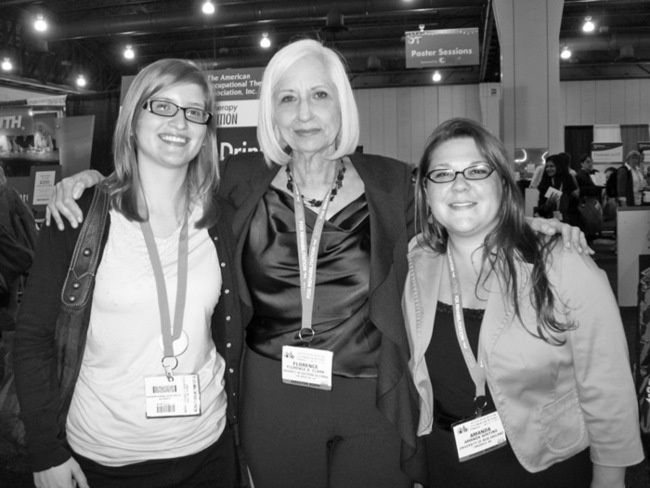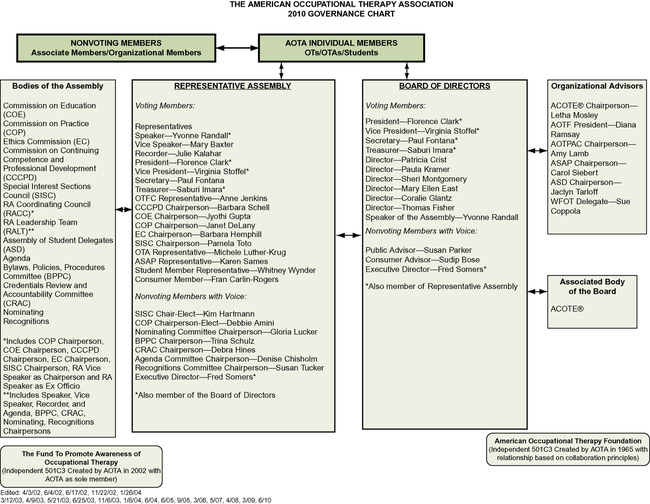After reading this chapter, the reader will be able to do the following: • Describe the mission and major activities of the occupational therapy (OT) professional associations • Describe the activities of the American Occupational Therapy Association, World Federation of Occupational Therapists, and state associations • Describe how professional associations assure the delivery of quality occupational therapy services • Identify ways professional organizations contribute to the professional development of their members WINIFRED SCHULTZ-KROHN, PhD, OTR/L, SWC, BCP, FAOTA Associate Professor of Occupational Therapy Department of Occupational Therapy It is customary for professions to establish a professional association. The stronger and better supported the association is, the greater the benefits for the individual members. A professional association is organized and operated by its members for its members. It exists to protect and promote the profession it represents by (1) providing a communication network and channel for information, (2) regulating itself through the development and enforcement of standards of conduct and performance, and (3) guarding the interests of those within the profession.1 The professional organization for OT practitioners in the United States is the American Occupational Therapy Association (AOTA). Originally incorporated in 1917 as the National Society for the Promotion of Occupational Therapy, the association’s name was changed to its present version in 1923. The World Federation of Occupational Therapists (WFOT) was established in 1952 to help OT practitioners access international information, engage in international exchange, and promote organizations of occupational therapy in schools in countries where none exists.3,5 Each state also has a professional organization for OT practitioners living in the state. Although there is frequent collaboration between AOTA and the individual state associations, the state associations are funded and operated independently from the national association. It is beneficial for OT practitioners to have a good understanding of the professional organizations and the services they provide. Because it would be impossible to discuss each state association in this text, this chapter describes the world and national associations. Readers are encouraged to join and support their professional associations at the world, national, state, and local levels. See Appendix D for the contact information for organizations. The mission of AOTA is “to advance the quality, availability, use and support of occupational therapy through standard-setting, advocacy, education, and research on behalf of its members and the public.” In keeping with this mission statement, AOTA directs its efforts to (1) assure the quality of occupational therapy services, (2) improve consumer access to health care services, and (3) promote the professional development of its members.1 Members at all levels are encouraged to become actively involved in AOTA by serving on committees, attending the annual conference, reviewing journal articles, presenting at conferences, and holding elected and volunteer positions. The COOL (Coordinated Online Opportunities for Leadership) database was developed to encourage membership participation at a variety of levels. Members complete a profile and indicate areas of expertise and interest. AOTA staff and committee chairpersons will use the database to find volunteers for a variety of organization and membership activities. Active membership helps OT practitioners become informed.1 AOTA is made up of a volunteer sector and paid national office staff. See Figure 6-1 for a description of the organizational structure of AOTA. The paid office staff is employed at the headquarters in Bethesda, Maryland, and performs the day-to-day operations under the management of the executive director. The national office staff is organized around four divisions: Business Operations Division (membership, marketing, corporate relations, and exhibits and advertising); Division of Public Affairs (federal affairs, reimbursement and regulatory policy, state affairs, and public/media relations); Professional Affairs Division (accreditation, education, practice, and professional development); and Finance, Information Technology, and Administration Division.
Professional Organizations

American Occupational Therapy Association Mission
Membership
Organizational Structure
![]()
Stay updated, free articles. Join our Telegram channel

Full access? Get Clinical Tree


Professional Organizations

